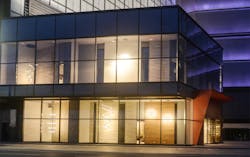Answering Five Frequently Asked Questions About LLLCs
What exactly is an LLLC lighting control system?
A Luminaire Level Lighting Control (LLLC) system is one in which each general lighting luminaire (light fixture) has three things onboard:
- A controller that dims the light up and down, as well as turning it on or off;
- A presence sensor of some type that looks for human activity in the area; and
- A network chip that allows the luminaire to communicate with other nearby luminaires and wall stations.
The combination of these three capabilities creates the most flexible, advanced, and efficient lighting control system possible. For a retrofit project, a wireless LLLC system is simple to install: Just swap out the existing fixtures and wall stations. That’s it. No need to add sensors or rewire anything.
This sounds complicated and expensive. Is this worth the time and money?
Well, that depends. The reality is that there is a certain amount of complexity inherent in these systems. Early network lighting control (NLC) systems were complex by design, and unfortunately alienated all but the most tech-savvy users. Newer systems have reduced and hidden their complexity to provide a better user experience all around. Almost any modern lighting control system is more complex than stand-alone line voltage sensors and switches, but LLLCs have more benefits than any other system type, including:
- Better, more reliable, sensor coverage;
- Maximum energy savings;
- Easily reconfigurable control zones.
Do LLLCs generate a whole bunch of data? Do I have to do something with all that?
Some LLLC type lighting control systems can collect several types of data, in addition to turning the lighting on and off. They may collect and share occupancy data for each room in a building, enabling real-time room scheduling or HVAC setback adjustments. Or, if the lighting network is Bluetooth based, LLLCs may enable interior wayfinding or asset tracking. Imagine putting a Bluetooth tracker on your keys and always being able to find them, powered by the lighting control system.
All these features are great, but they are secondary to the purpose of a lighting control system: to enable occupants to turn the lights on and off. If you have the desire and capabilities to collect and use all the data that an LLLC system can generate, that’s great! More power to you. But if you, or your client, do not, that’s perfectly fine, and you’re not really missing out. The use cases for advanced data-driven system integrations are very specific. Don’t worry if they don’t line up with your needs.
Why do I need so many sensors? One or two should be fine.
One or two sensors just don’t do as good a job. How many times have you seen or heard about a space where the occupants have disabled or overridden the sensors? Why is that? Typically, there are two main reasons why occupants reject lighting control systems. The first has to do with the occupants’ expectations and lack of sufficient communication with the occupants regarding the change. During a retrofit, the existing system (usually simple line-voltage switches) gets removed and replaced with a new system that looks and operates differently. Electric lighting is essential to the usability of indoor spaces, so imagine walking into your office and finding out, to your surprise, that the lighting has changed — and it operates differently. That could be annoying to occupants. In that context, rejection makes a fair amount of sense.
The second reason, simply, is poor sensor coverage. Too often, the layout of a room might change from what it was when sensor location decisions were made initially. It’s likely that the contractor just picked a spot in the middle of the room where there was a joist on which to mount a j-box.
An LLLC system with a sensor integrated into each general lighting luminaire vastly increases the quality of sensor coverage in a room. This, in turn, will enable the system to function more seamlessly and allow room occupants to focus on their work, without the lights turning off on them all the time.
Won’t the occupants be annoyed by lights changing all the time?
Think about this: how many times a day do you notice changes in daylight? Daylight and sunlight are constantly changing — the sun moves across the sky, clouds pass in front of it, trees move in the breeze. Most of the time, we hardly notice these changes for one specific reason. They happen slowly. Instead of the sun rising immediately, there is a gradual fade from the dark of night to sunrise to high noon. These gradual fades allow the movement of natural light to recede to the back of our perception.
Now, in the commercial & industrial lighting context, a two-hour fade on an occupancy sensor won’t actually save any energy in most circumstances. Anecdotal research has settled on a fade time of seven seconds for non-adjacent visible light fixtures as a good balance between saving energy and not disturbing occupants. In some contexts, this might be too long. For instance, many lighting control systems allow for the fade up and fade down times to be set separately. If you are moving quickly through transition spaces in an open office, a seven-second fade up time might feel slow. In that case, a three- or four-second fade up time, coupled with a seven-second fade down time, might be more appropriate, particularly with the knowledge that a fade up is triggered by an event in the space such as an occupant pushing a button or walking through a sensor area. In those circumstances, the lighting change is not the primary cause of the distraction, and so isn’t noticed as an interruption.
While each building and situation is somewhat different, these are some common items to think about when exploring LLLC systems. For more information about LLLCs, including recent research, visit the DLC’s website and/or email the author at [email protected].
Jason Jeunnette is Technical Manager for Building Integration and Controls at the DesignLights Consortium.
About the Author

Jason Jeunnette
Jason Jeunnette is the DesignLights Consortium’s technical manager for building integration and controls. He can be reached at [email protected].
